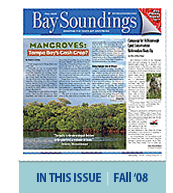 |
||||||||
EDITOR’S DESK
Readers who just see the cover stories in this issue might walk away thinking that the best way to protect Tampa Bay is to place a value on environmentally sensitive land and then buy it.
That’s actually a very small part of the picture. While it’s critically important that we recognize the intrinsic value of natural areas and preserve significant sites, it’s just as important that we minimize our own personal pollution.
People like John Starnes (see story page 13) and those who served on the Tampa Bay Estuary Program’s workshops on residential fertilizer use (see story page 3) are leading the way toward that goal.
The problem is that an ever-increasing percentage of pollutants in Tampa Bay comes from our yards and neighborhoods. Residential fertilizer use in Tampa Bay’s watershed has nearly doubled over the past five years. Even in Pinellas County, where land uses have not changed dramatically, fertilizer use skyrocketed from about 6000 tons in 1998 to 15,000 tons in 2006.
Starnes could grow everything he needs to survive on a lot in south Tampa without chemical fertilizer or pesticides if he weren’t such a “foodie.” His chickens thrive on leftovers collected from dumpsters outside nearby restaurants, and he harvests fresh eggs. Even his weeds are recycled as food for snails that become a high-protein food source. Unless he has company, he lives without air conditioning in a house shaded by plants that mostly provide food. (He’s also a world-famous rosarian with three roses carried by two major retailers, but that’s another story.)
Most of us aren’t going to give up AC, eat snails or turn our entire yards into edible landscapes, but Starnes shows that it can be done. He’s minimizing both his global carbon footprint – because the produce he eats hasn’t traveled 1500 miles – and his imprint on Tampa Bay because his gardening practices minimize nutrients in stormwater runoff.
The 42 representatives who helped develop the TBEP’s fertilizer guidelines, ranging from environmentalists and local government to the lawn care industry, came to a consensus on almost every issue. Education was deemed to be such an important topic that a full workshop was scheduled to brainstorm ways to reach out to homeowners, neighborhood associations, retailers and lawn care professionals to share information on proper fertilization techniques.
As a region we’ve made remarkable strides toward protecting and preserving Tampa Bay and the rich natural resources of its watershed. In many ways, we’ve set an example for the nation’s other estuaries by showing that it is possible to restore an estuary, but it’s an ongoing process as our population continues to grow. We’ll all need to work together to make that happen.
— Victoria Parsons
P.S. – Don’t forget to vote, particularly if you live in Hillsborough County, and tell your friends and neighbors about ELAPP. An overwhelming percentage of voters support the program – once they know what it does – but it faces voter approval in challenging economic times.
